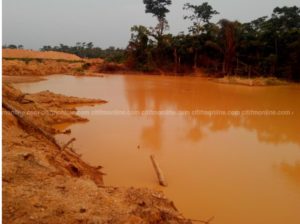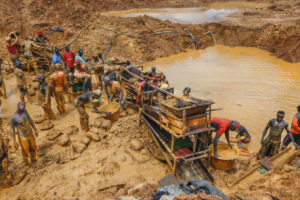
Accra, Ghana//-“Walking was unbearable; I couldn’t even sit or stand straight. I’m not happy. The pain stopped me from participating in many things, but with the wheelchair I can now move around for some fresh air”.
This statement was made by Kwabena Owusu, a 25-year-old young man who got paralysed after falling into 60 feet (ft) pit dug and abandoned by illegal artisanal and small-scale gold mining (ASGM) popularly known in Ghana as “galamsey” during a hunting expedition in a forest at Adansi Adwafo in the Ashanti Region.
Mr Owusu, who received a wheelchair donated by Galaxy Foundation Ghana, an NGO, has been paralysed for the past 24 months.
Officials of the foundation, touched by his predicament, said they would later raise funds to support his surgery.
He needed a laminectomy, a surgical procedure where part of the vertebral bone is removed to relieve pressure on the spinal cord.
“We offer free services and surgical procedures for those who are less privileged and cannot afford the cost, David Hagan, Chief Executive Officer of the Galaxy Foundation Ghana, said.
These kinds of horrible stories are common in gold mining communities where galamsey activities are rampant. Mr Owusu is lucky to be supported by the NGO and his family.
While the majority who go through these distraught complications are left to fend for themselves. Some also lose their lives after falling into some of the galamsey pits.
It is an undeniable fact that abandoned galamsey sites and open mine pits are dangers that threaten human lives and livestock in gold mining communities.
Also, they change the natural drainage patterns and become reservoirs and breeding places for mosquitoes and other blood-sucking insects that cause diseases.
Who are these illegal miners?
The recent sudden increase in galamsey activities has involved a combination of foreign ‘investors’, mainly Chinese nationals, politically-connected locals, equipment/machinery providers, rural villagers, traditional rulers, out-of-work miners, and migrant labourers.

Essentially, these foreigners and well-heeled Ghanaians have provided access to capital, enabling the import of advanced machinery and allowing illegal miners to exploit large surface areas in short periods.
MORE EFFECTS OF ILLEGAL MINING
The illegal ASMG operations require the removal of overlying layers of surface vegetation, forest, and rock.
Illegal mining activities, which are conducted hurriedly and without oversight, lead to deforestation and loss of biodiversity, accelerated soil erosion and sedimentation, water and air pollution, among others.
The result is a landscape deprived of vital ecosystem services, bearing significant ramifications for local populations who depend on the land, forest, and water resources for their survival.
Water pollution
Most of the major sources of water from Ankobra, Ayensu, Birim, Densu, to Pra are all terribly polluted due to the galamsey activities.
These young, unprofessional gold miners engage in illegal gold mining on a small scale. They usually don’t have mining permits, but their activities are one of the major causes of water pollution and environmental degradation in the country.
Because of the lucrative nature of the business, the illegal miners hire bulldozers, excavators and other heavy earth-moving equipment to dig deep into the ground in search of gold.
In this process, rivers, streams and other water bodies get polluted by them. They also use chemicals, including mercury and cyanide, in mining activities, which pollute the water bodies.
When communities downstream or along galamsey pits drink the water containing the chemical residuals, they result in health complications, according to health experts.
Recently, Ghana Water Company Limited (GWCL), a state-owned company responsible for potable water supply to all urban communities in the country, announced that it is spending too much money on the processing of water at its various water treatment plants due to the galamsey activities.
The Director of Communications of GWCL, Stanley Martey, added: “The company also uses four to five times more chemicals for treatment than it should be using, due to pollution from illegal mining activities”.
This development, officials at the GWCL and water resources experts have warned that the country would import water for consumption in the future, if the illegal mining activities are not checked.
Furthermore, the unregulated galamsey activities disrupt aquatic lives, including fishes and aquatic environments and also threaten access to potable water.
For instance, in Tarkwa in the Western Region, various studies have shown water quality levels unsuitable for human consumption due to the illegal gold mining activities there.
Mining communities where galamsey operations are rampant, without alternatives, may continue to rely heavily on contaminated water for domestic uses.
Deforestation
The major gold mining regions in Ghana-Ashanti, Western, Eastern, Western North, and the Ahafo regions also have good vegetation cover. But the activities of the illegal small-scale miners, coupled with illegal logging, have caused and continue to cause deforestation and forest degradation in these regions.
Environmentalist Kwame Owusu observed: “As illegal mining communities increase, illegal logging and fuelwood harvesting also increase to fulfil demand for construction and cooking needs of the people there and beyond”.
Surface mining, he noted, could displace farmers, resulting in knock-on effects of deforestation in untouched areas.
Mr Owusu was quick to add that surface mining could lead to agricultural intensification due to land scarcity, and land degradation from the loss of ecosystem services that are critical to rural jobs and the wider economy.

Again, the ASGM activities may force affected farmers to cultivate marginal crops. Gold and cocoa especially maintain an uneasy coexistence, with the two vying over land and labour, and galamsey is a likely contributor to decreased cocoa health and yields, experts said.
Land degradation
The unbridled digging and dredging of alluvial soils for gold by the galamsey miners leads to the loss of arable land and the degradation of rural landscapes.
This destruction of farmlands has created food insecurity issues as well as increases in the price of food commodities in the galamsey areas in the country.
For instance, in the cocoa-growing southwest, galamsey directly affected 43,879 hectares in 2015—up 250 per cent from 2011—and an additional “impact zone” of over 500,000 hectares, according to the World Bank’s 2020 Environmental Analysis on Ghana.
Heavy metal contamination
The report also noted that recovering gold creates pollution from arsenic, lead, and mercury, among other elements. Contaminants are discharged into the immediate environment, including as effluent in water bodies.
Excavation churns naturally occurring metals to the surface, affecting riverine flora and fauna, as well as humans, it added.
Proximity to gold mining sites has been linked with contaminated soil and irrigation water. Analysis of sediment cores from Lake Amponsah, Western Region, showed increasing arsenic, copper, cadmium, and lead contamination over time, consistent with acid mine drainage (the outflow of acidic water from mines), Hogarh et al., 2016 said.
Mercury
Mercury used in galamsey activities contaminates land, water, and the atmosphere. Illegal miners use it as an inexpensive way to separate gold from impurities, mixing the two to form an amalgam, and then burning off the mercury to leave behind a gold nugget, Yaw Mensah, an environmental scientist, explained.
Mercury vapour inhalation is the primary route of occupational exposure, though mercury can also be absorbed through the skin, according to health experts.
Levels of mercury have been comparable between miners and villagers, signalling migration of pollution away from the mine area and into the broader community.
When gold amalgamation occurs at home, women and children are exposed to toxic mercury fumes, leading to serious long-term health consequences, they added.
There are indications that diet may be another exposure pathway: fish near ASGM sites have been found to harbour three times the mercury suggested by the U.S. EPA, while samples of cassava, a staple of the Ghanaian diet, have also revealed contamination, as stated by Rajaee et al. (2015.
Efforts to stop illegal small-scale mining
Present and successive governments have tried their best to stop the activities of illegal artisanal and small-scale gold miners in the country.
For instance, between 2013 and 2015, more than 6,800 illegal Chinese miners were deported by the Ghanaian government, according to the Ministry of Lands and Natural Resources.
Similarly, on December 17, 2018, the two-year ban on galamsey was lifted after an Inter-Ministerial Committee on Illegal Mining had successfully developed a comprehensive policy framework to regularise small-scale mining across the country, but the problem still lingers on.
Why the failures
The agencies within Ministry of Lands and Natural Resources (MLNR) and Ministry of Environment, Science, Technology and Innovation (MESTI), most notably Environmental Protection Agency (EPA) and Minerals Commission (MC), but also Land Commission, Precious Minerals Marketing Company (PMMC) Ltd, and Geological Survey Department, have been unable to provide services effectively to deal with the galamsey menace.
While the district-level government institutions designed to tackle environmental and mining issues, particular galamsey issues have been equally constrained.
Other contributory factors, according to the Policy Advocacy Officer at the Natural Resource Governance Institute (NRGI), Nasir Alfa Mohammed, include: inadequacies in personnel, logistics, and training are a major impediment to the enforcement of laws/regulations and the implementation of activities.
Also, the EPA and Water Resources Commission (WRC) need additional resources to deal with galamsey’s harm, however, budgetary allocation has been unequal to the magnitude of the task.
Some citizens, especially those living in rural mining communities, complained about the difficulties in accessing the current ASM framework. This poses a cumbersome compliance burden and perversely incentivises illegality.
Galamseyers’ views sampled by African Eye Report mentioned bottlenecks in registration and licensing— that is time commitment of going to Accra to obtain the permit, the high cost of fees, and bureaucracy.
What can be done to help halt illegal gold mining?
Short-term measures such as clarification and codification of roles and responsibilities in the fight against the galamsey menace should be made public.
The EPA must be given formal authority over uncontrolled hazardous waste sites in galamsey communities, while the government should provide sufficient staffing and resources for monitoring, regulatory enforcement, and community interaction.
Additionally, MESTI, EPA, MLNR, Forestry Commission (FC) and MC should endeavour to foster reciprocity in the public sector-mining community relationship, visiting areas vulnerable to galamsey and raising awareness about negative impacts; easing community access to officials to ask questions, receive advice, report concerns, among others.
The above-mentioned ministries, commissions and agencies should also train their staff to use technologies, namely, drones, remote sensing, to identify, screen, and target ASGM interventions.
Bottom line
Gold mining is a major contributor to national wealth, gross domestic product and poverty reduction in the country.
Whereas the large-scale mining companies operating in the country are committed to responsible and sustainable mining practices, illegal artisanal small-scale gold miners have chosen the path of irresponsible mining practices, thereby destroying human lives, aquatic lives, vegetation, water bodies, felling of economic trees, and the destruction of the environment.
By Masahudu Ankiilu Kunateh, African Eye Report
Email: mk68008@gmail.com


